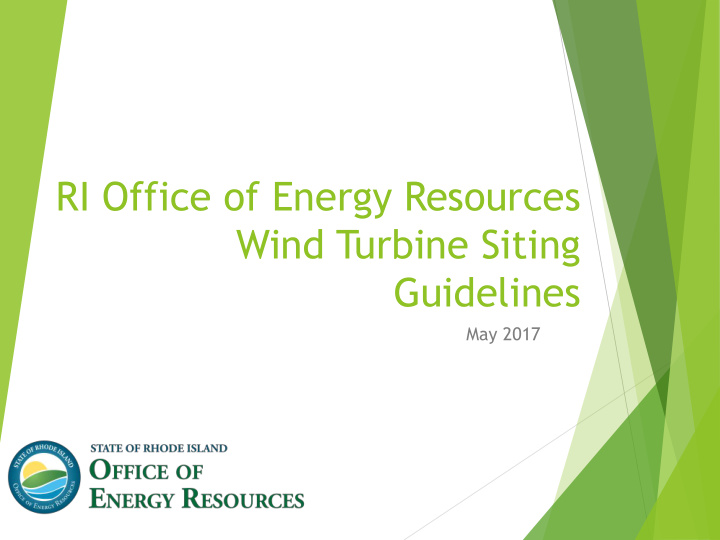



RI Office of Energy Resources Wind Turbine Siting Guidelines May 2017
Overview 1. Benefits of Wind 2. Policy Context 3. Applicability of these Standards 4. Zoning Considerations 5. Recommended Standards 1. Setbacks 2. Noise 3. Shadow Flicker 4. Other Community Impact Standards 5. Environmental 6. How these Standards can be Applied
The Benefits of Wind GHG Emission Reductions Electricity Supply Diversity In-State Investment and Economic Activity
Policy Context State Energy Plan 2012 DOP Wind Siting Document Zoning Ordinances Community Comprehensive Plans Governor’s 1,000MW goal by 2020
Applicability of these Standards Land-Based Large-Scale: ≥ 200 feet in height OR Rated to produce ≥ 100 kW of power
Zoning Considerations Use Tables: permitted use, special/conditional use, prohibited Three Categories of Standards: Public Safety: Setbacks Community: Noise, Shadow Flicker, Other Environmental Can lessen the restrictiveness of community impact standards by zone, if desired
Setback Standards: Public Safety The Concerns The Recommended Standard: 1.5x the total turbine height From closest point of property lines, public or private ways & occupied buildings
Noise Standards: Community Impact Option 1 (PREFERRED) Municipal Maximum Sound Levels Decibels add logarithmically This means 50 dB + 44 dB ≠ 94 dB It’s actually = 51 dB Steps: Model sound from turbine 1. Sum (logarithmically) modeled sound with Municipal Maximum Sound 2. Limit (MMSL) Determine if the sound level increase is likely to surpass the MMSL by 3. more than 1dB(A)
Noise Standards: Community Impact Option 2 Measured levels above ambient Steps: Model sound from turbine 1. Measures the site’s pre -construction ambient sound 2. Determine if the summation of the two will exceed the allowable 3. increase over ambient
Noise Standards: Community Impact PROS & CONS for each Source: 2010 West Michigan Wind Assessment Issue Brief
Shadow Flicker Standards: Community Impact Recommended Standard: ≤ 30 hours per year at occupied structures or sites permitted for occupied structure construction at time of project permitting
Other Community Impact Standards Visual Impacts These standards encourage the submission of viewshed/sightline analyses in project proposals HOWEVER, unless pre-existing visual impact standards exist for a municipality, wind developments should not be subject to a visual impact standard assessment Signal Interference Notify nearby communications towers
Environmental Standards Follow the US Fish and Wildlife Service’s Voluntary Guidelines (http://www.fws.gov/ecological- services/es-library/pdfs/WEG_final.pdf) At minimum, a literature review should be conducted as well as a basic site characterization visit Engage the U.S. FWS, the RI DEM, and other appropriate environmental advisory groups as early in the proposal process as possible
How can these standards be applied? Review and Amend Use Tables Draft an ordinance to set standards for zones where wind development is permitted Use the guidelines document to help establish standards Allow flexibility by zone when appropriate Allow case-by-case flexibility, if standards cannot be met, through the Zoning Board
The Importance of Flexibility ➢ Blanket standards do not allow regulations to be molded to the needs of different sites and different project neighbors ➢ Increased Impact Special Use Permits (IISUPs) ➢ Zoning Board should have final say ➢ IISUPs should require notification letters and should allow affected land-owners to voice their concerns to the Zoning Board
Key Links & Resources in the Document Municipal Development Proposal Checklist US Fish & Wildlife Voluntary Guidelines Federal Aviation Agency (FAA) Regulations & Department of Defense wind siting tool MassCEC Acoustic Study Methodology for Wind Turbines Sample IISUP language (should be reviewed by legal counsel) Sample MA Ordinance language Property Value Studies
Link to full document: www.energy.ri.gov/renewable/landwind/ Contact Information: Becca.Trietch@energy.ri.gov 401-574-9106
Recommend
More recommend